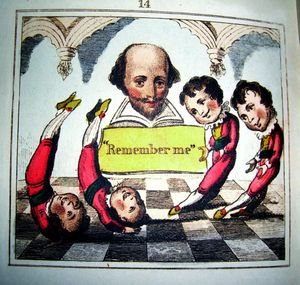Advertisement

 An example of quotations
An example of quotations
from the children's book described in the lectureA lecture on children's books at the Bodleian kept us all in rapt attention as Clive Hurst flashed images of story books and creative illustrations on the overhead projector. I enjoyed how this speaker continually reminded us about the historical climate and perceptions of the society where these children's books came from. Also, his slides consisted
only of pictures. What can I say--I learn visually.
The advent of actual children's literature was somewhere in the mid 18th century. Hurst showed us several educational materials from before this time, but these new materials were intended to entertain. The example gave a perfect example of his point. In the introduction of this particular story for children, the author explains that they wished to "allure" or "entice" children to pursue reading for entertainment. As a sober sidenote, Hurst tells us that children were not "enticed" to do anything and in fact were told to do something and beaten if they did not obey.
One of the first series of books written for children were called
The Gigantic Histories, starring two illustrated giants who went on many adventures. The books, in contrast with their title, were small enough for little hands to hold

 Shown is a personified colon
Shown is a personified colon
and instructions on how to use itand read easily, a little more than five inches. At this time subscriber lists were formed so that if you wished to read the next book in the series, you would put down half the cost upfront and your name would actually be printed in the subscriber list at the back of the book.
My favorite example was an educational book about punctuation where each mark was illustrated as a character. Basically, the little book was filled with pictures of people in the shapes of a colon, semi-colon, exclamation point, and quotation marks.
The second half of the day was spent at the botanical garden in the city of Oxford. Started in 1645, the massive amount of different kinds of plants was simply amazing. The guide pointed to a tree (a Taxus Baccata, also known as English Yew) that was planted in 1645. Surprisingly, it wasn't all that big. The garden initally planted only those kinds of plants that were thought to be medicinal. They are famous for a few different scientific contributions, one being the fact that they have a rare plant called Euphorbia Stygiana. A famous picture of J. R. R. Tolkien was taken
in this garden in front of a large, winding tree. The tree, which I have snapped a picture of, was thought to be a possible inspriation for the "Ents" or the tree people he describes in Lord of the Rings.
Advertisement
Tot: 0.167s; Tpl: 0.011s; cc: 15; qc: 51; dbt: 0.0625s; 1; m:domysql w:travelblog (10.17.0.13); sld: 1;
; mem: 1.2mb

 An example of quotations
An example of quotations 
 Shown is a personified colon
Shown is a personified colon









Ivy
non-member comment
lovely photos